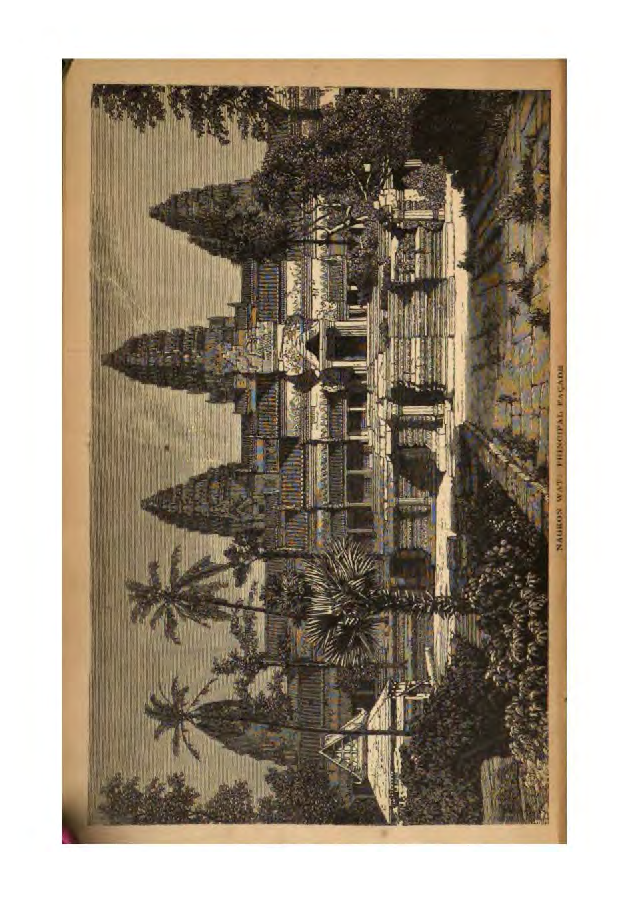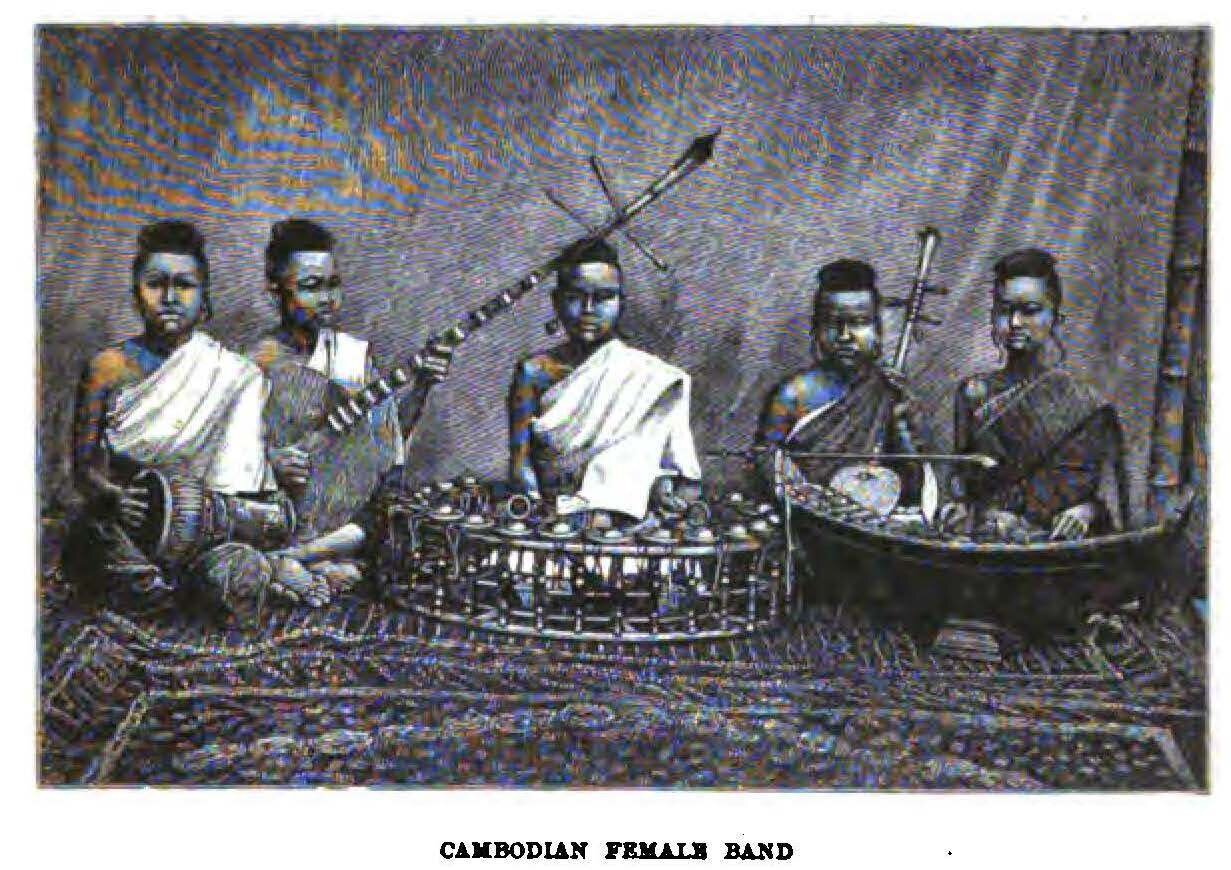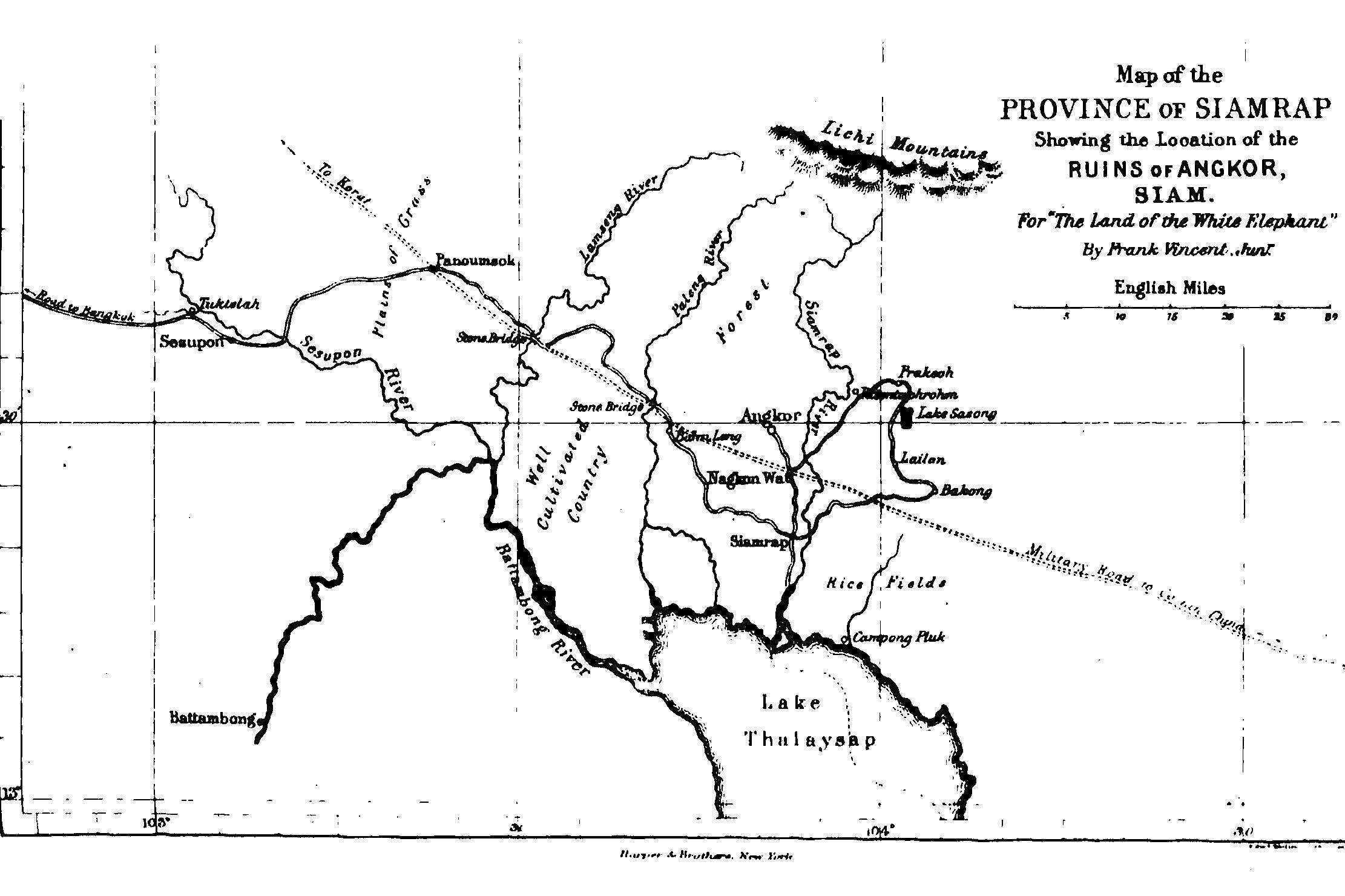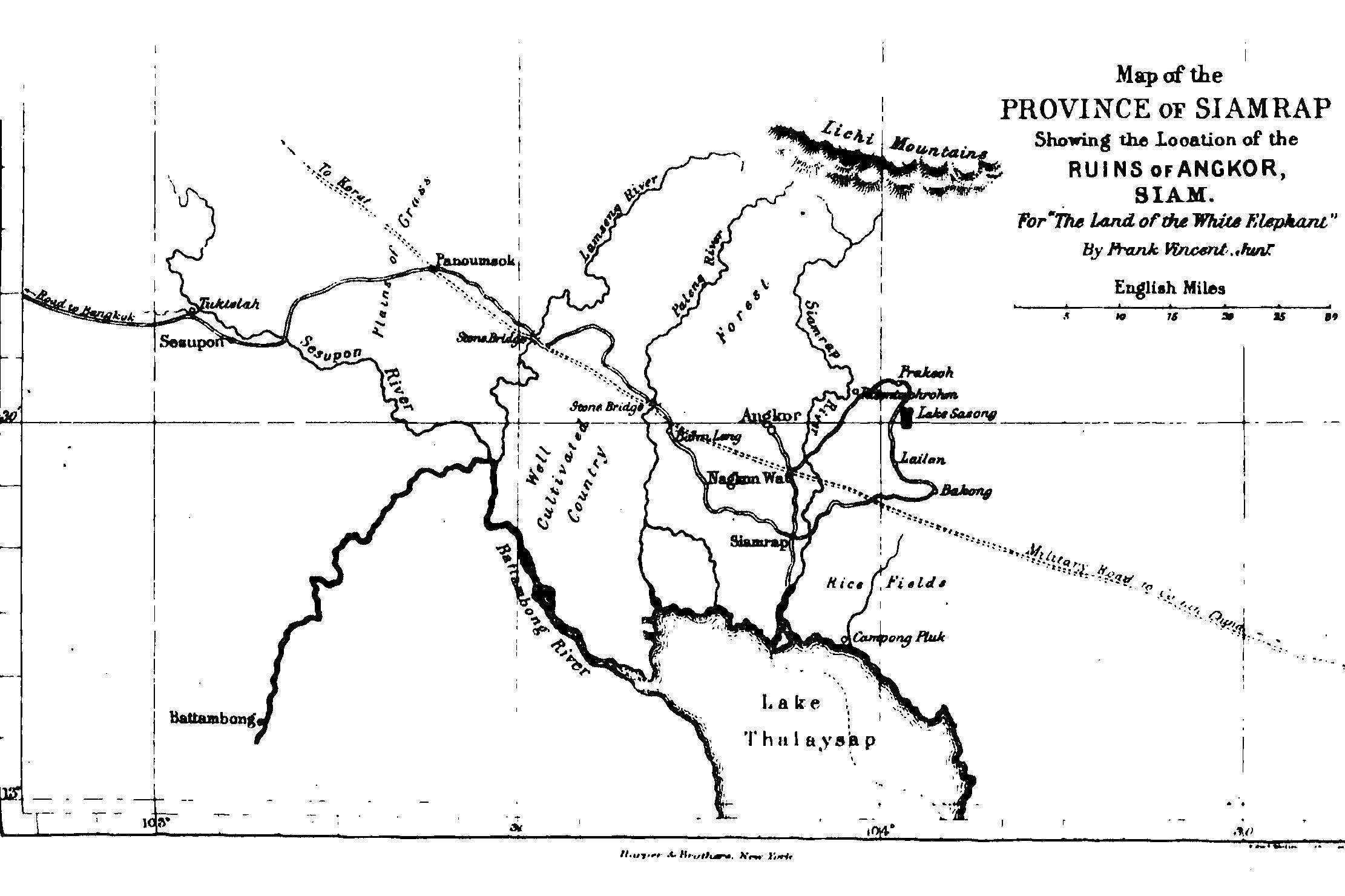The Land of the White Elephant: Sights & Scenes in South-Eastern Asia
by Frank Vincent
Part of a 2-year business trip from Burma to Siam, Cambodia and Singapore, the first published description of Angkor by an American citizen.
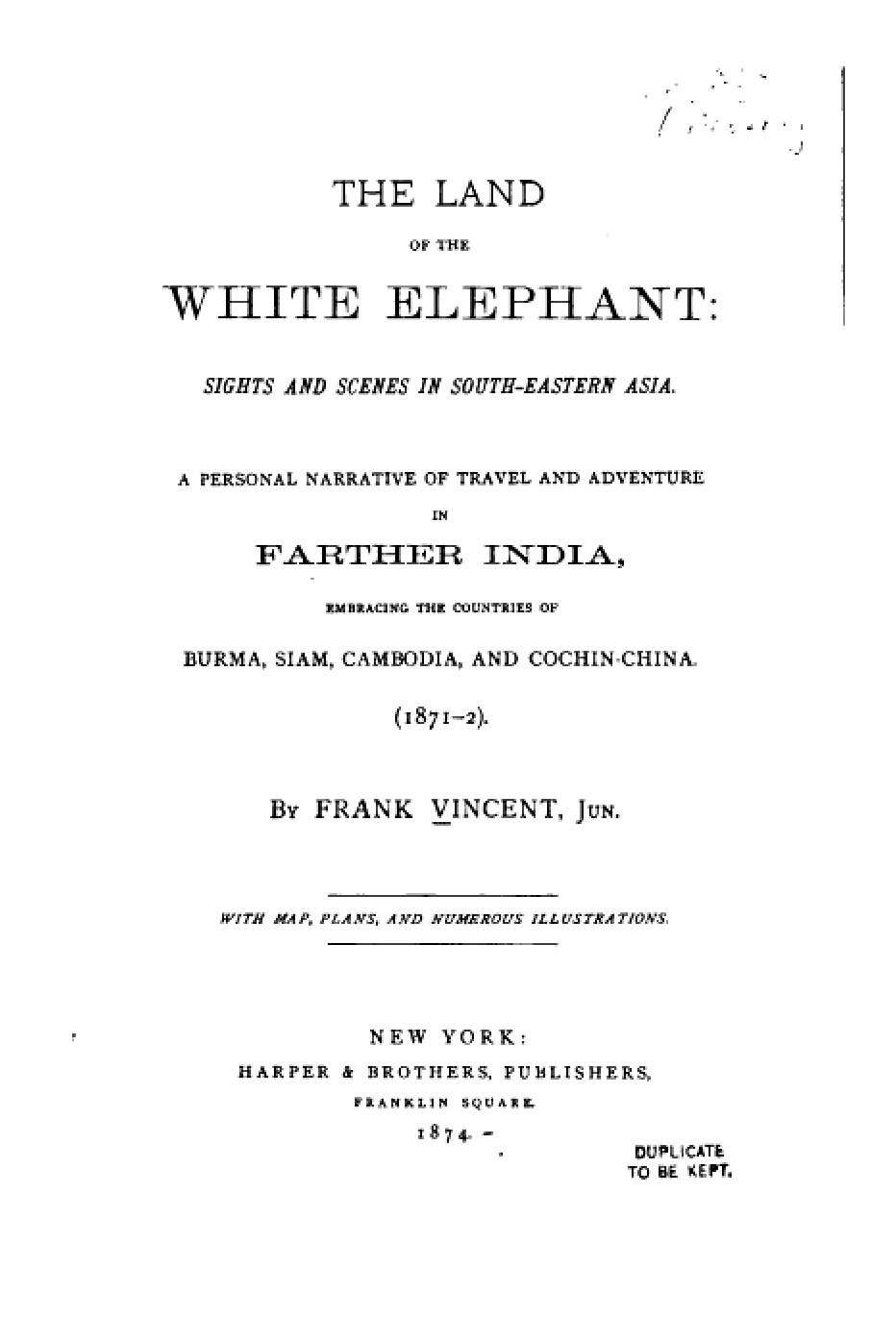
Type: e-book
Publisher: Harper & Brothers, New York
Edition: ADB digitized edition
Published: 1874
Author: Frank Vincent
Pages: 316
Language : English
ADB Library Catalog ID: eTRAVINC
pdf 12.7 MB
Subtitle: “A PERSONAL NARRATIVE OF TRAVEL AND ADVENTURE IN FARTHER INDIA, EMBRACING THE COUNTRIES of
BURMA, SIAM, CAMBODIA, AND COCHIN-CHINA (1871−2).
The first published travel account by an American citizen through the lands of Burma, Siam, Cambodia and Cochin-China, Frank Vincent Jun.‘s book is just a gem. Life at the royal courts, lay of the land in the 1870s, description of the early stages of Angkor rediscovery (chapters XX to XXIII), and a reporter-like rendition of a Khmer wedding in Siem Reap 150 years ago showing that traditions are stunningly stable.
In 1871 – 1872, the author was involved in the development of US-Siam trade which, according to American consul F.W. Partridge consisted mainly in sewing machines and arms from the American part (report to the Senate). He recalls how he prepared his trip to Angkor with the help of J.H. Chandler, Partridge’s predecessor who had been a Baptist missionary in Siam during twenty-eight years and had become the King’s private secretary: “Mr. Chandler asked His Grace the best and safest route to the temples of Angkor, in eastern Siam, and he replied, ‘That by Kabin, through the forests, about east:’ the other route being by sea down the gulf to Tung Yai, and then crossing overland to the ruins.” Vincent went to Angkor with F.W. Partridge and Rev. S.C. McFarland, an influent Protestant missionary in Siam.
Contrary to other Western travelers of the time, who were prone to lift from or paraphrase Henri Mouhot’s account, Vincent’s descriptions are precise, colorful and often insightful. When needed, he gladly quotes his sources, either Mouhot or Adolf Bastian, mostly. The origin of the beautiful engravings illustrating the book, however, remains untold. Especially for the Cambodia section, we suppose they were made from photographs by Emile Gsell.
On the other hand, his map of Siamrap (Siem Reap) area is rather accurate, and shows the ‘Lichi Mountains’ (Phnom Kulen) in the northeast:
Among numerous observations, we will quote this portrait of King Norodom I:
“The strong contrast between the bamboo huts of the city and the grandeur of the palace is painfully apparent, and for the expenses of beautifying the latter His Majesty is said to appropriate private property without indemnification. Still the King deserves great credit for his remarkable energy, his adoption of European ideas and notions ; notwithstanding he is said to despise his subjects now he no longer fears 0them, to mock at Budha when he is in the mood, and to tread under foot the ancient etiquette. Norodom has reigned now for about eleven years, and his rule
has been in the main just; he is much liked by the people generally, which, perhaps, is as great praise as
any ruler could wish or could obtain. Since my visit the King has left his capital and country, and, determined
to see something of the great world for himself, voyaged to Hong Kong, and on to Shanghai, and, I believe, Pekin. Is not progress in the East quite as rapid and wonderful as in the West ?
“We descended from the observatory and walked with the King across the square to the artificial mountain. This was a huge affair, as high as the palace, built of bamboo and covered with stout pasteboard, which was coloured to represent the lower section, stone; the next, silver; and the upper, gold. It tapers gradually to the top, to which a path winds, sometimes passing through arches, and tunnels, and grottoes, and valleys, and the whole. exterior is covered with plants of various kinds in pots and boxes, and wooden and clay figures of men and animals were soon to be
added to its manifold attractions. Upon the summit is a wooden platform, and here the King, with due solemnity and ceremony, will cut the hair of the Princess his daughter. On one side of the ‘mountain,’ upon large mats spread on the ground, sat the nobles and chief men of the kingdom, assembled to meet the King, who is there accustomed of an evening to confer with them on matters affecting the public well or woe, but at that time on the absorbing topic of the approaching fête. Many of the nobles followed us to the top of the ‘mountain,’ and there the King talked
with them in a very jolly, familiar sort of way, smoking all the while a Manilla cheroot as much as eight inches
in length ; in fact, His Majesty smokes incessantly, now a green-leaved, now a dry native, afterwards a German cigar, then a Manilla, etc.
“Returning to the palace’, I observed that all the guards — some fifty or sixty in number- were natives of the Philippine Islands. His Majesty had but few troops in commission ; these were formerly instructed by a French officer, but he having been dismissed the service for some irregularities of conduct, military affairs were at a very low ebb at Panompin [Phnom Penh].”
Frank Vincent Junior was an America free agent, mingling with royals around South East Asia during a trip combining business, art recollection and probably some kind of intelligence mission for the sake of US authorities.
His obituary in the New York Times, right beneath renowned French archaelogist Gaston Maspero’s one, shows that he donated his art collection to the Metropolitan Museum:
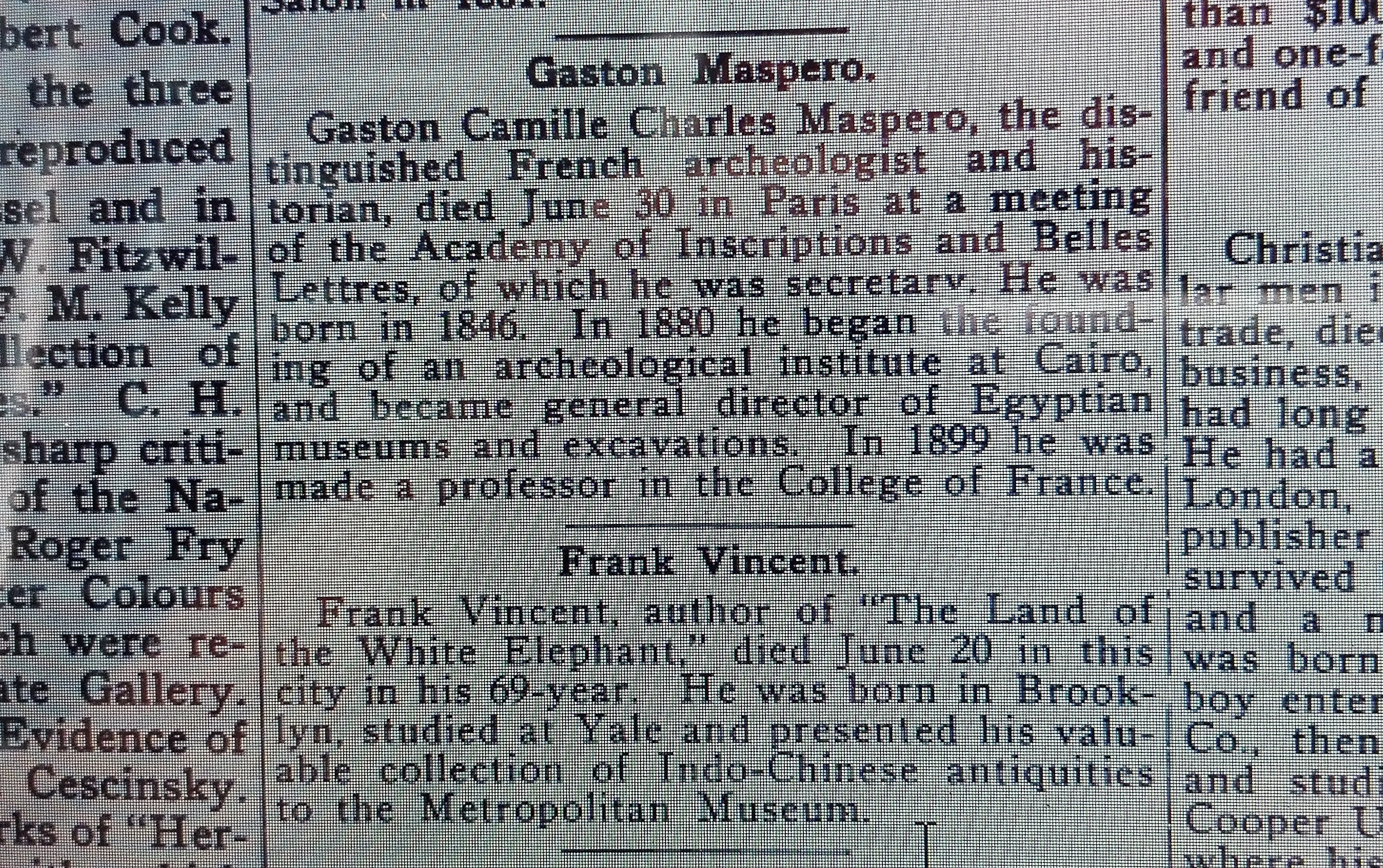
Tags: Southeast Asia, Burma, Siam, Singapore, Phnom Penh Royal Palace, American travelers, 19th century, Philippines
About the Author

Frank Vincent
Frank Vincent Jr. (1847, Brooklyn, NY ‑1916, New York, USA) was an American explorer, businessman and art collector.
The first American citizen to publish a detailed account on Angkor while he was a guest at the court of the King of Siam, left his important collection of Indo-Chinese art to the New York Metropolitan Museum. He was listed as “Patron” in the Annual Report of the Trustees of the Metropolitan Museum of Art, No. 36 (1905).
Before him, D.O. King (David Olyphant King), a scion of the Vernon and King families of US-Asia traders from Newport, Rhode Island, had sent a letter to the Royal Geographic Society of London on Feb. 7, 1859, describing his visit to Nokon (Nakhon Wat, Angkor) the year before, and challenging several geographical assertions made by French bishop of Siam Mgr. Jean-Baptiste Pallegoix (1805−1862).
Nevertheless, a witness of that time, Jacob T. Child (1832−1905), who was Minister Resident (Consul General) of the USA in Bangkok from 1884 to 1888, wrote in his memoirs — The Pearl of Asia, Reminiscences of the Court of a Supreme Monarch or Five Years in Thailand, Donohue Henneberry & Co., Chicago, 1892 — that “while making a tour of the East, Frank Vincent, Jr., in company with Rev. S. I. McFarland, made a visit to Angkor, the first Americans that had penetrated the vast wilds of that section, and in his “Land of the White Elephant” gives an elaborate description of Nagkon Wat, which has also been described by M. Mouhut [Henri Mouhot, the American writer struggling with this family name, which he also spelled Mauhut and Mahout!], whose work he drew liberally upon for information, in which he describes this temple as “one of those temples a rival to that of Solomon, erected by some ancient Michael Angelo that might take an honorable place beside our most beautiful buildings. It is grander than anything left us by Greece or Rome.” (p 91)
Paul Lavy noted in 2023
To the best of my knowledge, the first significant published account of an American visitor to Angkor is that of Frank Vincent Jr. (1847 – 1916), a businessman, explorer, and art collector who traveled throughout mainland Southeast Asia in 1871 – 1872.50 In 1885 he donated his collection of sculpture from Cambodia and Thailand to the Metropolitan Museum of Art, thus making it the first major American museum with holdings of Khmer sculpture, albeit mostly small heads of humble quality. Due however to a veritable French colonial monopoly over Cambodia, it should come as no surprise that the more typical path for Khmer sculpture into the United States occurred primarily through art dealers with offices in
Paris, such as Ching Tsai Loo (1880 – 1957), Paul Mallon (1884 – 1975), and Robert Rousset (1901 – 1981). Among the earliest American collectors to acquire Khmer art were Denman Waldo Ross (1853 – 1935) of Boston, a Harvard professor who visited Angkor in 1910; Alfred Fiske Pillsbury (1869 – 1950) of Minneapolis, the director of Pillsbury (flour) Mills; and lawyer and banker John Lionberger Davis (1878 – 1973) of St. Louis. Thanks to the donations of Ross, and his collaborations with the influential curator and art historian Ananda Coomaraswamy (1877 – 1947), the Boston Museum of Fine Arts developed a particularly noteworthy collection of Khmer sculpture by the 1920s. [Paul Lavy, “Many Lives of Ancient Khmer Sculpture: From the Pre-Angkorian Period to Contemporary Cambodia”, in B. Kim, K. Pyun (eds.), Teaching South and Southeast Asian Art, Springer, 2023, p 32.]
Frank Vincent’s Obituary in the New York Times, 1916.

